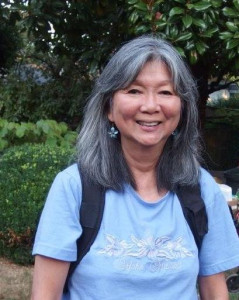
Bette Lee Photo Giveaway!
If you’ve been to a protest during the past three decades, you’ve probably seen Bette Lee, the short, slight woman behind the camera, always in the thick of things, documenting the resistance that Portland is famous for. From the 1990 march to condemn the murder of Mulugeta Seraw by neo-Nazi skinheads to OccupyPDX in 2011; from the 1991 protests against the first Gulf War to sHell No! the successful blockade in 2015 of Shell Oil’s icebreaker bound for the drilling fields in the Arctic; from the 2000 May Day police riot against peaceful demonstrators to 100 Days of BLM protests in 2020, Bette Lee has been there to create images from an activist point of view. You can listen to an interview of Bette Lee about her work by Patricia Kullberg. Bette Lee can be contacted at leebette@gmail.com.
To thank the generous supporters of community radio in Portland, the Old Mole Variety Hour is sponsoring a gift to 10 listeners who contribute during KBOO’s 2021 fall membership drive, kicking off September 15. Each contributor will be entered into a drawing at the end of the drive. Ten people will be selected to receive one 10X14 print of a Bette Lee photo. Winners may select any photo posted in this blog. These are beautiful and provocative images, suitable for framing. Scroll down to see the photos with Bette's commentary.
Every Monday morning at 9:00 AM, the Old Mole Variety Hour burrows down to the roots of the great issues of our time – the struggles of ordinary people for democratic and sustainable ways of life. The Moles go where corporate media fear to tread, supporting grassroots challenges to top-down authority and giving voice to movements that shake the foundations of an unjust society. Our perspective is socialist-feminist, anti-racist, anti-colonial and LGBTQ-positive. The Moles can be contacted at oldmolevarietyhour@gmail.com or through the Old Mole facebook page. Visit their KBOO webpage for a complete list of downloadable podcasts.
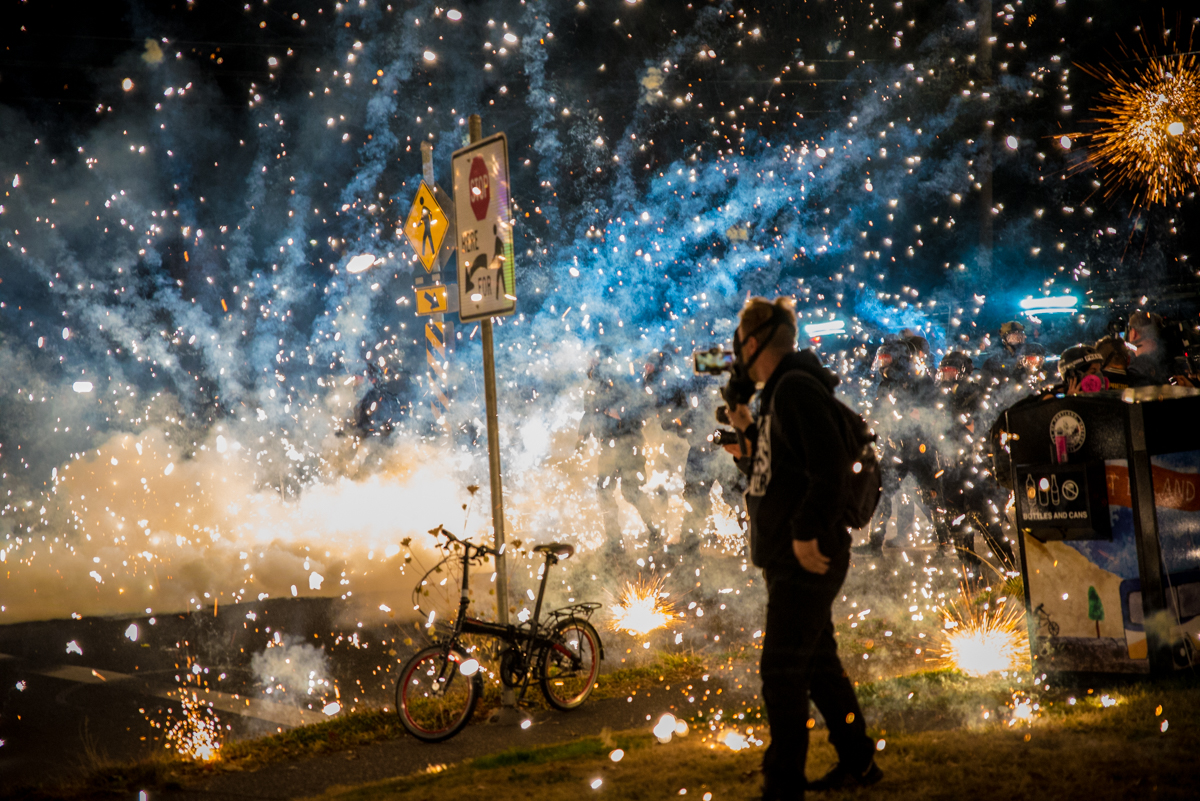
1. 2020 100 Nights of BLM Protests

2. 2020 The 100th Night of Black Lives Matter Protests
Portland became one of the main flashpoints of resistance during the BLM protests last summer which involved intense confrontations and police attacks. According to the DOJ, police arrested 1000 people, and used force over 6000 times. For over 100 consecutive nights, police pounded BLM protestors with tear gas, pepper spray, stun grenades, rubber bullets and impact munitions. Many people suffered injuries, and lawsuits were filed against the excessive use of tear gas and police violence. This protest on Sept. 5, 2020 to mark 100 nights of resistance in Portland was no different. The police set up a road block on Stark and 113th Street, declaring the march an “unlawful assembly.” About 400 protestors refused to comply with the police order to disperse, setting off fireworks and 3 Molotov cocktails, which set a man’s pants on fire. Several protestors rushed to put out the fire, preventing any serious injury. The police declared a riot, and wasted no time in charging at the protestors, firing rounds of tear gas and stun grenades. About 59 protestors were arrested.
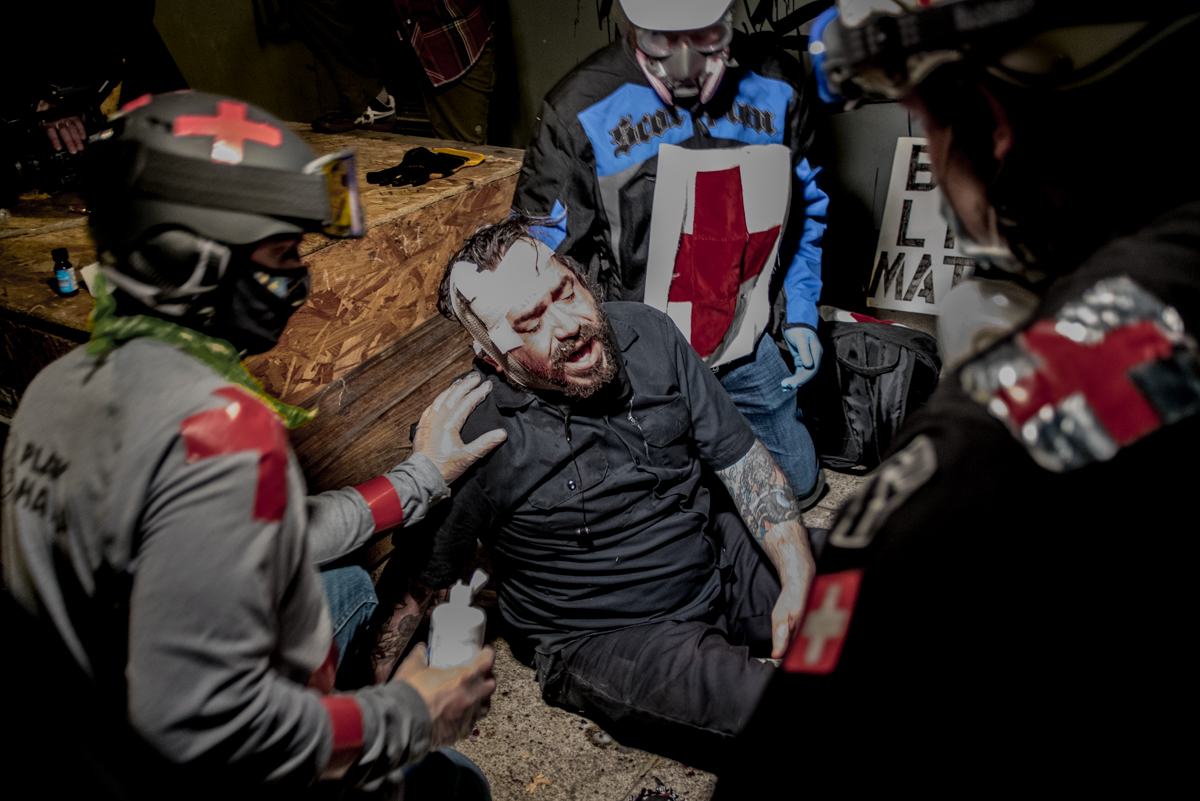
3. 2020 Street Medics
During the BLM protests last summer at the federal courthouse, many of the protestors were injured by the police and feds, who attacked us with tear gas, pepper spray, rubber bullets and impact munitions. Luckily, the amazing street medics, who put themselves at risk too, were there to treat our injuries. In this image, a protestor had collapsed after being beaten and injured by the police. Several street medics took care of him. Even though being out in the streets put us all in danger, the solidarity and mutual aid that the street medics and many others provided kept us going.
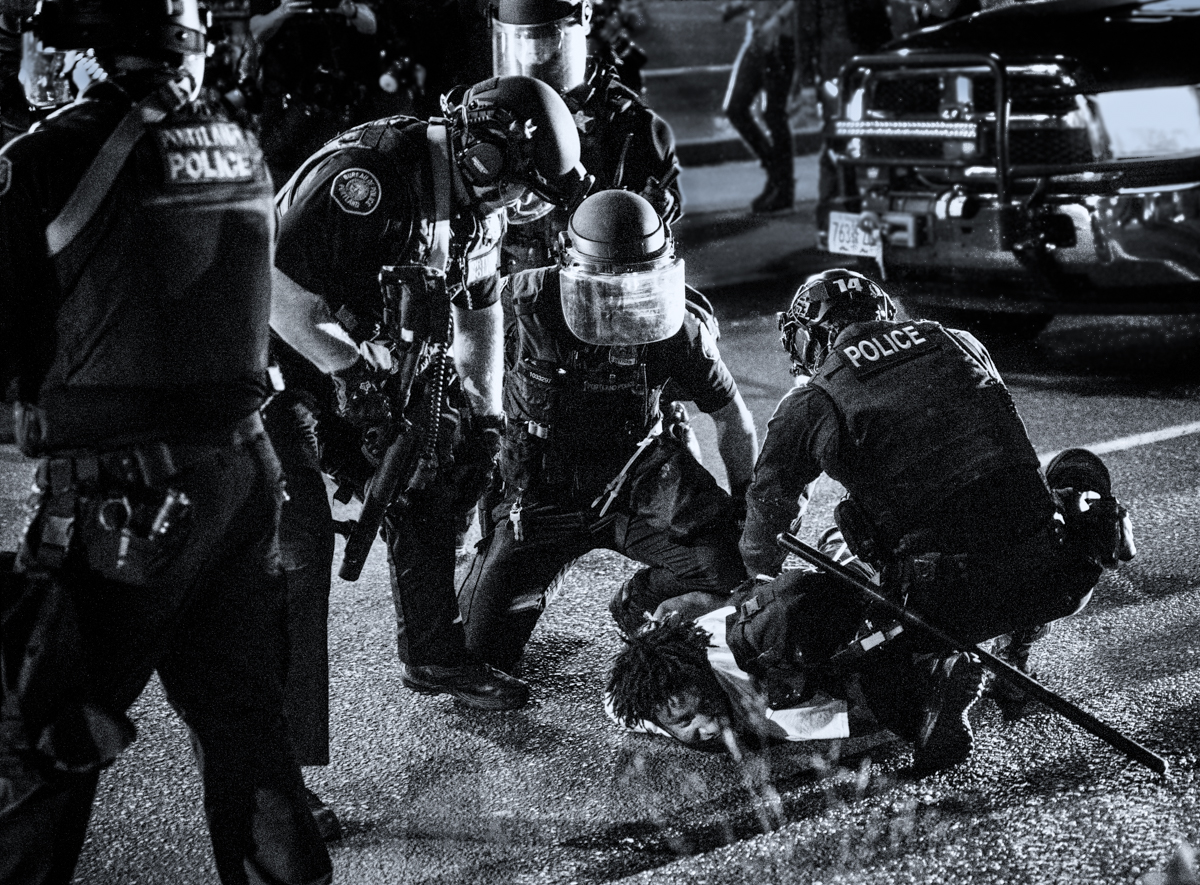
4. 2020 Police Arrest Demonstrator
Portland became one of the main flashpoints of resistance during the BLM protests last summer, which involved intense confrontations and police attacks. According to the Dept. of Justice, police arrested 1000 people and used force over 6000 times. For over 100 nights, police pounded BLM protestors with tear gas, pepper spray, rubber bullets, stun grenades and impact munitions. Many people suffered injuries, and lawsuits were filed against the excessive use of tear gas and police violence. After the federal troops, ordered by Trump to “protect” federal buildings in Portland in July, were reassigned to a different location, the intense protests downtown in front of the courthouse dwindled from thousands of people to a few hundred. The diehards, many of them ANTIFA and anarchists, began protesting at different police precincts in the city. This protest took place at the North Portland police precinct on August 10, 2020. As usual, the police declared the protest a “riot,” and bull-rushed the crowd. People ran off in different directions, and several were arrested.
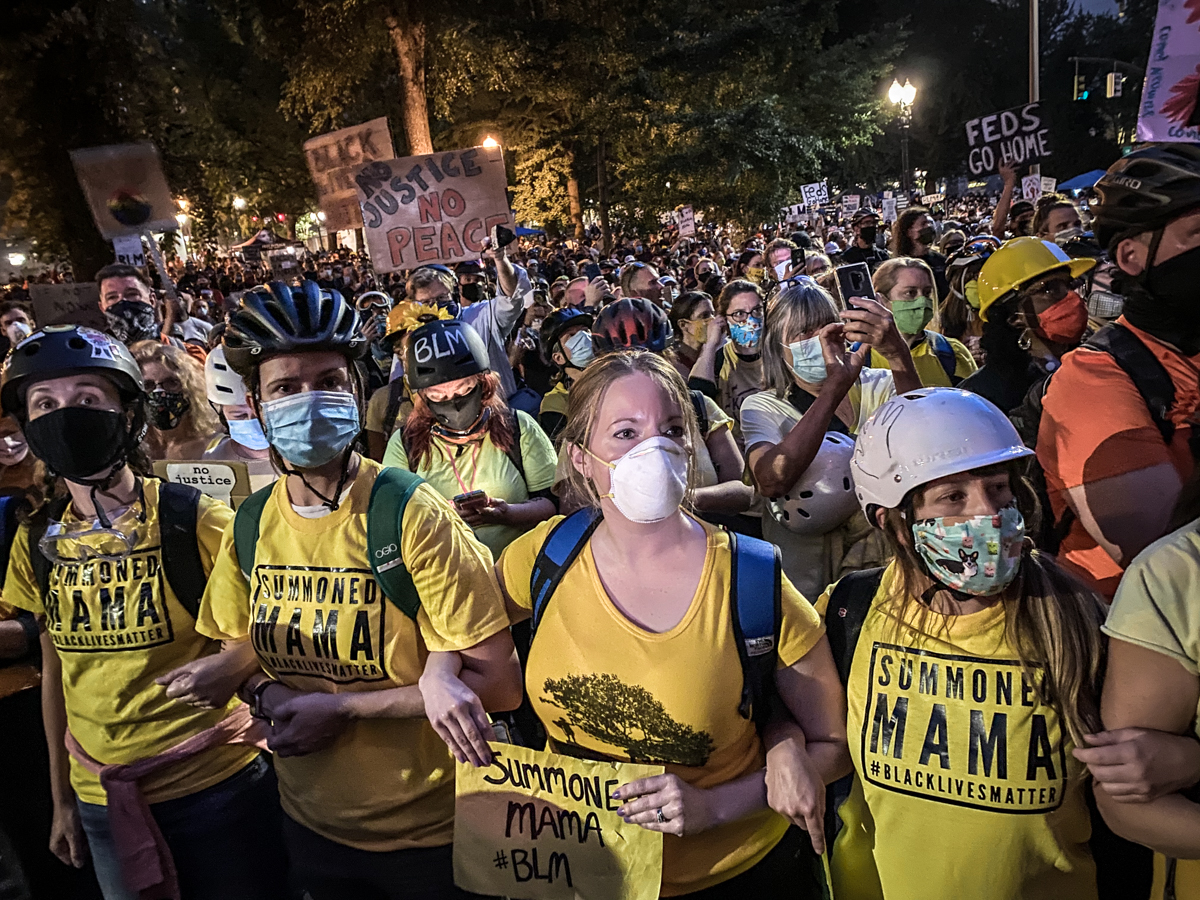
5. 2020 The Wall of Moms
When Trump ordered the deployment of over 100 federal agents to Portland under “Operation Diligent Valor” in July, 2020, the nightly clashes between BLM protestors and law enforcement in front of the federal courthouse and the Justice Center grew even more violent. Reports of unidentified feds in camouflage grabbing protestors off the streets, shoving them into unmarked vehicles and detaining them for hours without charge alarmed and angered many Portlanders. In late July, thousands of “moms” as well as “dads,” veterans, teachers, doctors, nurses, workers and many other concerned folks joined the nightly BLM protests at the courthouse. Many of us could no longer remain silent as the violent repression by the police and feds made us realize that what was at stake was not only racial injustice and social inequality, but also an attack on our 1st Amendment rights. Many “moms” formed a “wall” to protect BLM protestors from violent attacks by law enforcement in front of the courthouse. However, they too were attacked with tear gas, pepper spray, rubber bullets, stun grenades and impact munitions.
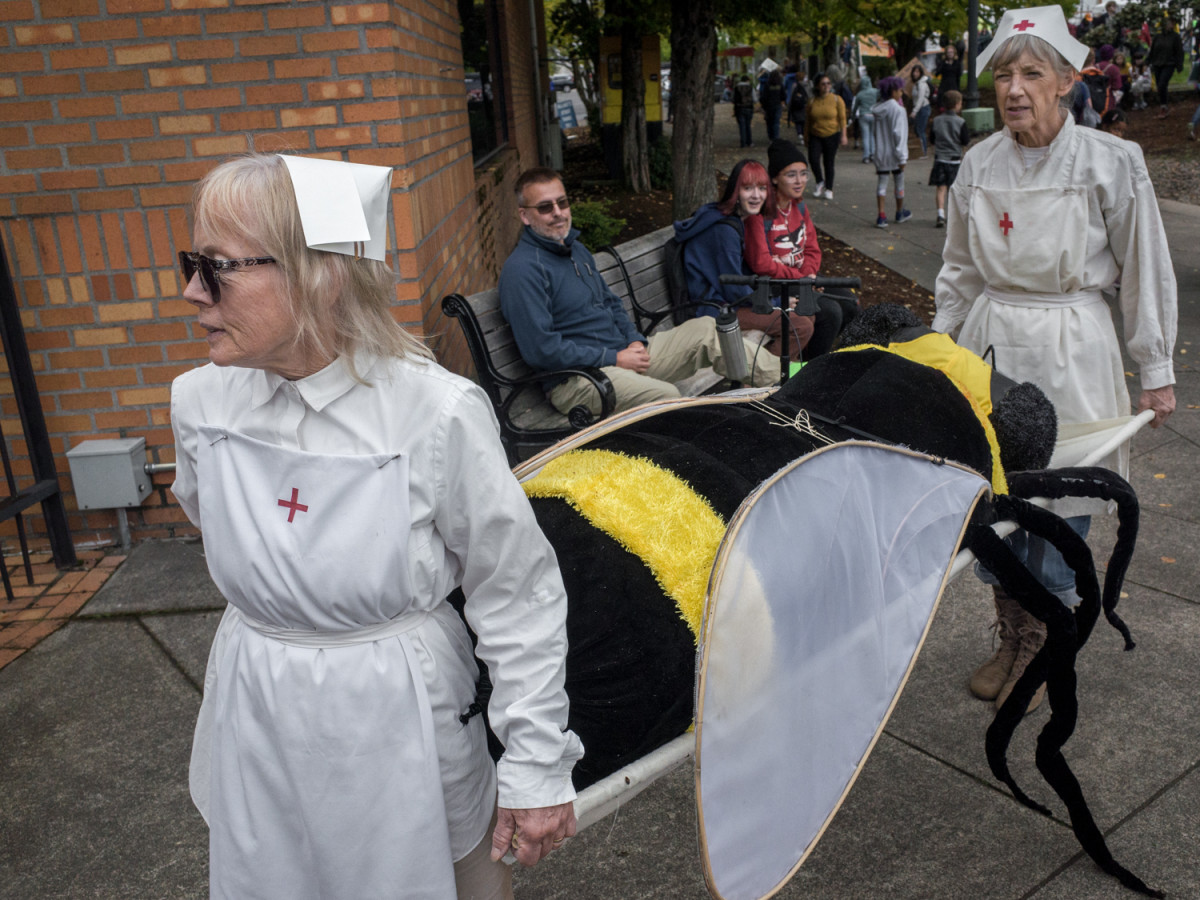
6. 2019 Global Climate Strike
Who says street protests can’t be fun and inspiring? What I love about street protests are the incredible creativity, humor and diversity that the protestors express to highlight their message. In this image, these two women dressed as nurses are carrying a giant dead/injured bee on a stretcher. When bees become extinct, we will be in deep trouble!
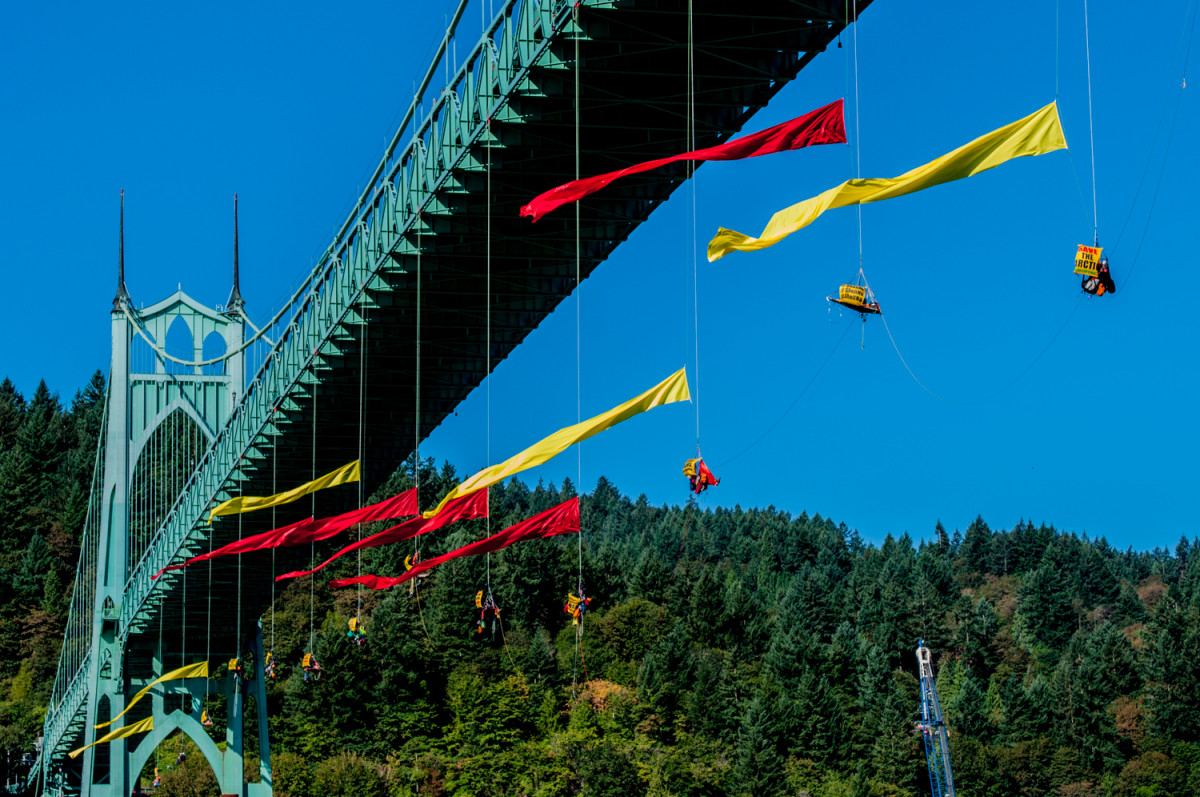
7. 2015 sHell No Direct Action
What an awe-inspiring, daring and utterly breath-taking direct action by Greenpeace activists at the St. John's bridge in Portland! Thirteen courageous and determined GP activists rappelled from the bridge and were suspended for over 40 hours in their attempt to stop or delay the Fennica, an ice-breaker owned by Shell Corp., bound for the Artic to be used for oil-drilling. They were supported by the "kayaktivists" who bravely tried to block the Fennica from sailing past the bridge, but were overwhelmed by the coast guard in their motorboats. We will always remember the beautiful image of this remarkable direct action of these activists hanging from the bridge, with their colored flags flying in the wind.
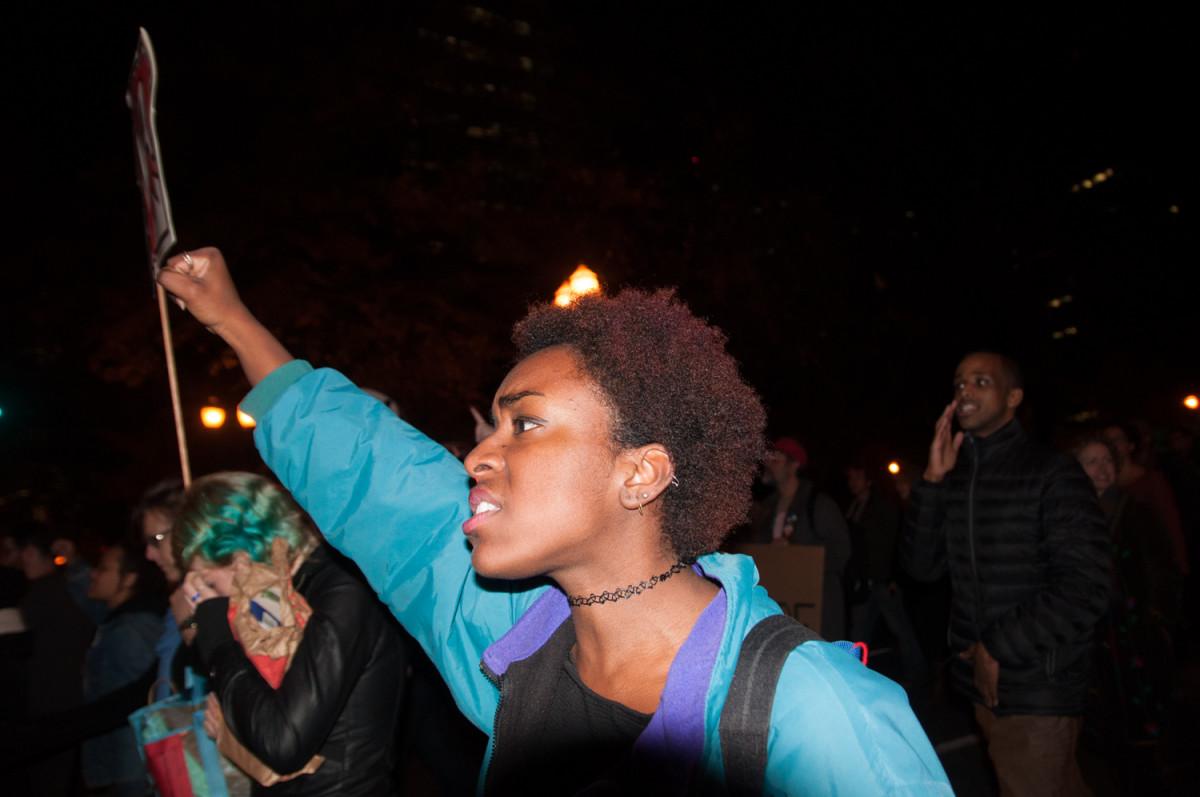
8. 2014 BLM march to protest the killing of Michael Brown
Hundreds of people took to the streets in Portland to protest the killing of Michael Brown, an 18-year-old Black teenager who had his hands up when a white police officer shot him 8 times in Ferguson, Missouri. People were outraged when the grand jury failed to indict the police officer for Brown’s murder. Many Black protestors held up signs saying “Am I next?” and “Black is not a crime.” “Hands Up, Don’t Shoot!” became a rallying cry for BLM protestors.
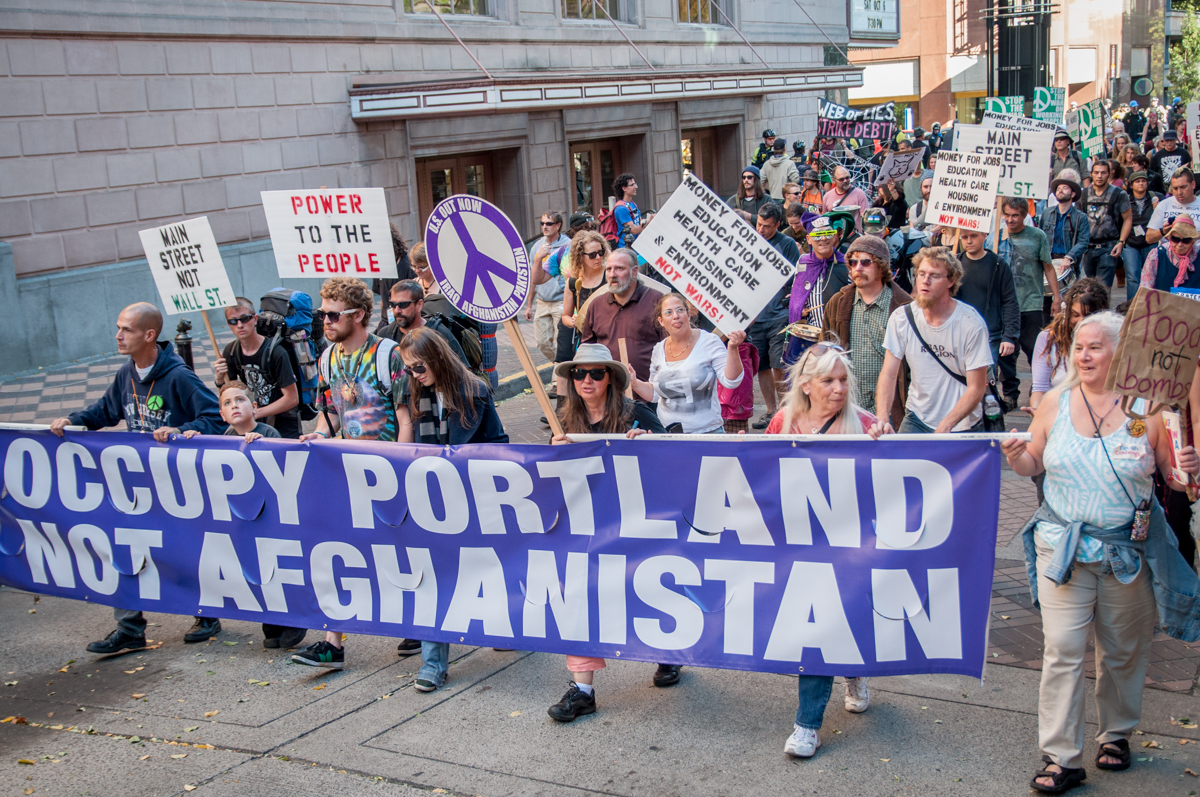
9. 2012 Occupy Portland, not Afghanistan
Occupy Portland, not Afghanistan was a rallying call to Portland’s anti-war and social justice activists and community groups to demand an end to US “war on terror” on Afghanistan and Iraq, and to divert the funds used for wars to provide jobs, housing, healthcare, education and environmental protection for the American people. Over 60 community groups participated in organizing the rally, march and teach-in on Oct. 6 and 7, 2012. The events commemorated the one-year anniversary of Occupy Portland and the 11th anniversary of the US War in Afghanistan.
It's telling that in the present frenzied torrents of news and commentary by the corporate media on this colossal military and humanitarian failure, hardly a word is said or heard from the thousands of people who protested for years against the US war and occupation of Afghanistan from 2001 onwards. War criminals and cheerleaders like George Bush, John Bolton, Paul Wolfowitz et al have been interviewed by the corporate media for their views, instead of being arrested and charged with war crimes and lies. The absence of any voices from the anti-war activists and groups in the corporate media is a potent way to control the narrative of US wars and imperial policies, especially when they end in failure like this one, which has cost over $2 trillion, with over 2448 American soldiers and 47,000 Afghan civilians killed, and over 2 million Afghanis forced to become refugees.
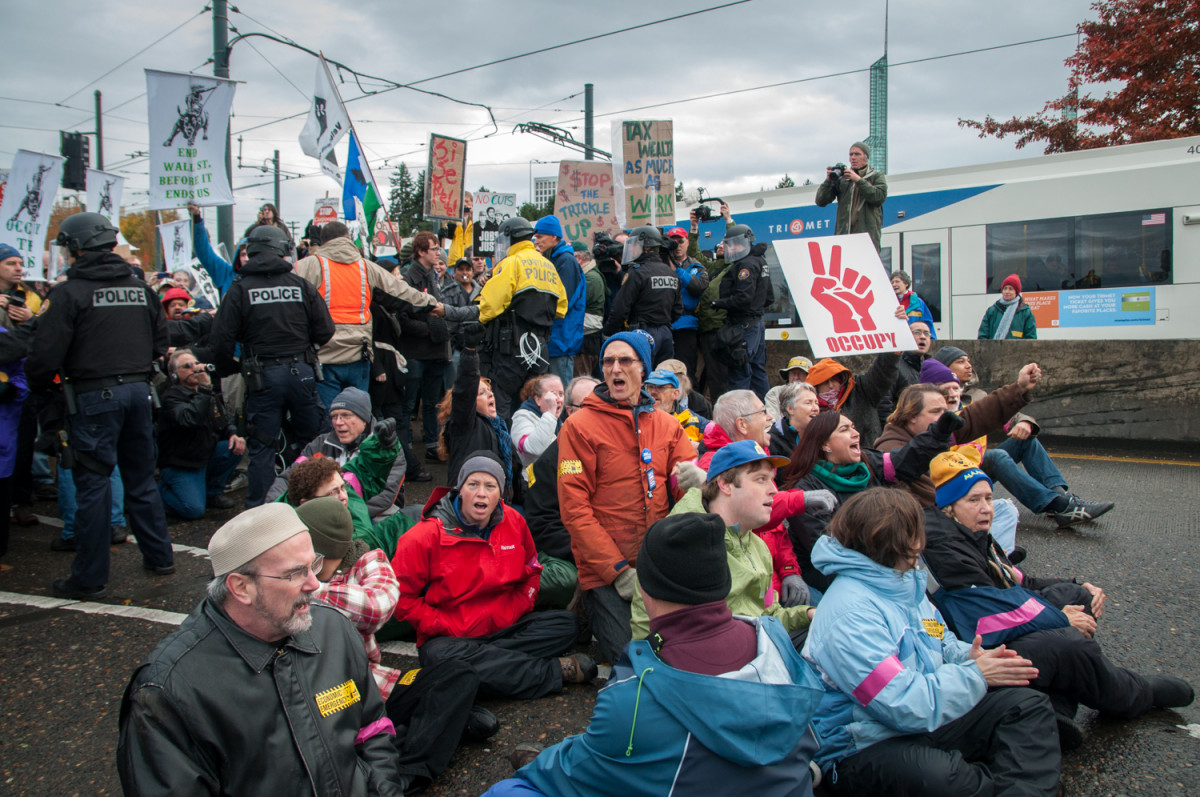
10. 2011 Occupy Portland, Occupy the Banks
Occupy Wall Street was a massive grass-roots resistance which spread across America against unfettered corporate power and greed supported by a corrupt system controlled by corporate elites (the 1%). Many people realized whose side the US government was on when they bailed out Wall Street and the big banks in the economic crash of 2008. Thousands of people joined the Occupy movement to rise up against corporate power, corruption, and social inequality.
Occupy Portland Portland organized many large protests in Portland, including Occupy the Banks on N17 (November 17). Over 1000 protestors marched in the streets, and several hundred blocked the banks including Bank of America, Wells Fargo and Chase Bank in downtown Portland to disrupt “business as usual.” The police responded by using pepper spray and police on horses to drive them away from the banks and the streets. In the early morning that day, over 200 protestors confronted the police at the Steel Bridge. 25 activists sat down to block the entrance to the bridge in an act of civil disobedience. They were all arrested for disorderly conduct by the police.
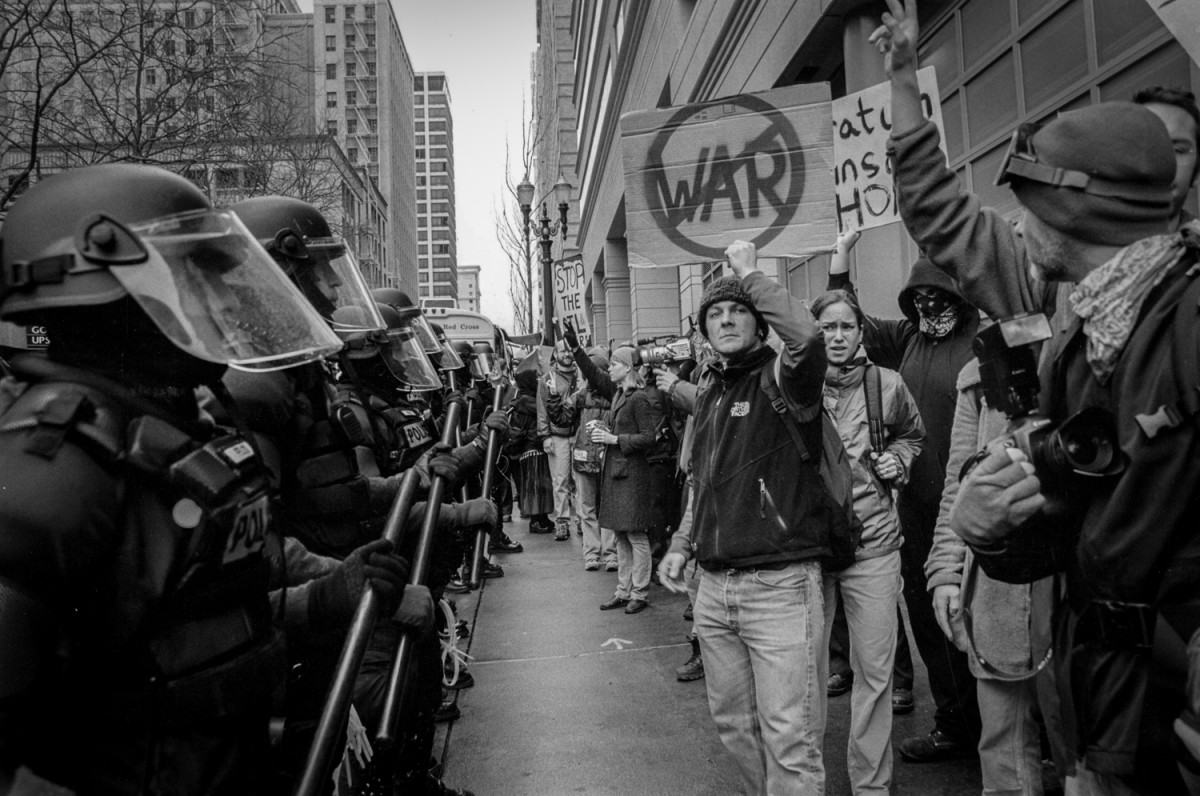
11. 2003 Protest against the War on Iraq
There were many protests in Portland against the war on Iraq before it began on March 19, 2003, when the US attacked Iraq with massive “Shock and Awe” air strikes under “Operation Iraqi Freedom,” which had been hastily changed by the Bush warmongers from its original name “Operation Iraqi Liberation” (OIL). Millions of people worldwide did not buy the lies about Iraq’s “weapons of mass destruction” and its alleged involvement in 9/11 that Bush, Cheney, Rumsfeld, Rice, Colin Powell and the rest of the war criminals used to justify the war on Iraq. Over 36 million people took part in about 3000 protests worldwide against the war in 2003.
The biggest anti-war protest in Portland occurred on Feb. 15, 2003 when about 30,000 took to the streets. Although the protests did not stop the war, opposition and protests against the war went on for years. In 2005, Cindy Sheehan set up “Camp Casey” (named after her son Casey who was killed in Iraq) outside Bush’s ranch in Crawford, Texas, which mobilized thousands of anti-war activists, including the Iraq Veterans Against War (IVAW).
However, the anti-war movement ran out of steam, and the number of people protesting at the annual anti-war demonstrations in Portland dwindled year after year. It was a painful realization that in the end, the anti-war movement failed to stop the US Empire’s “endless wars.”
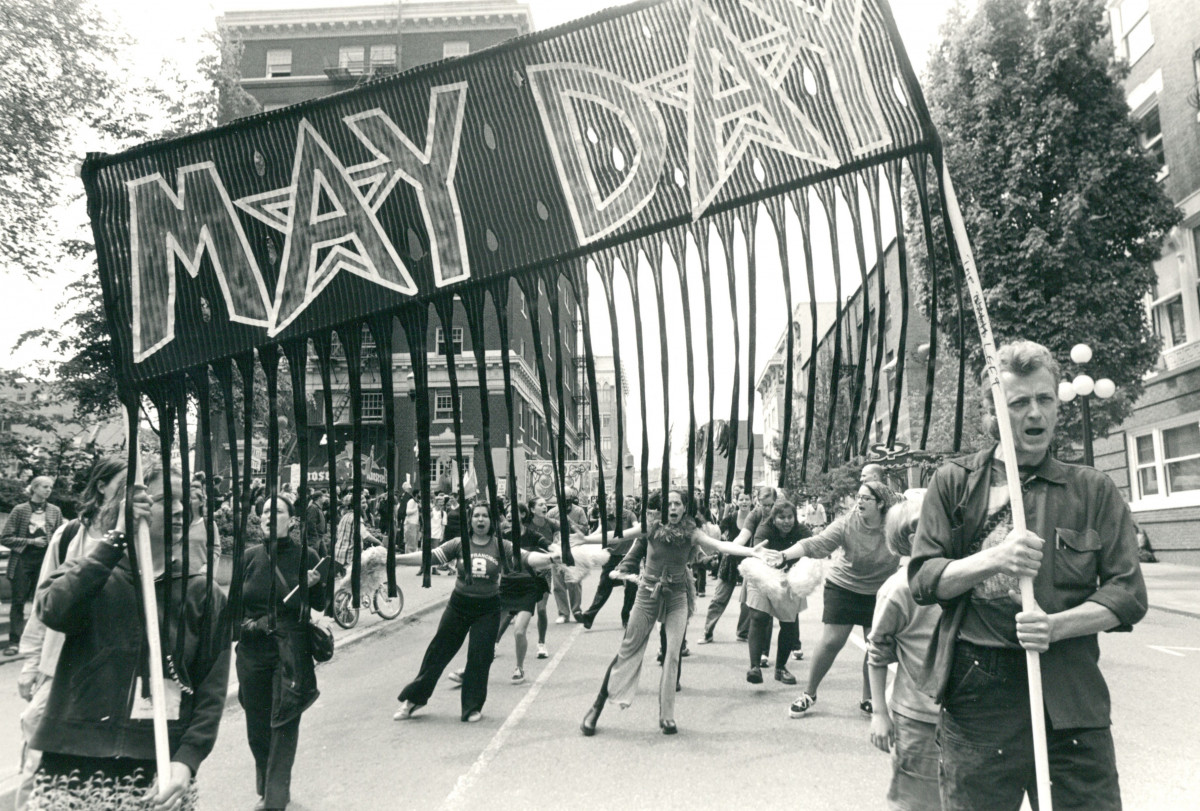
12. 2000 May Day
On this infamous 2000 May Day, the police attacked non-violent protesters with beanbags, pepper-spray, and even horses. Their military-style aggression shocked many protesters, bystanders, and city officials. Mayor Vera Katz, however, praised the police for their reaction. I remember the 2000 May Day as one of the worst cases of police violence against protesters. The celebration got off to a good start with people singing, dancing and handing out flowers. But soon after we started marching peacefully downtown, the police attacked us with batons, ATVs, beanbag rounds and pepper spray. They charged their horses at us and shot many protestors in the back with beanbag rounds as we tried to disperse. They even beat up or arrested bystanders holding shopping bags. I was appalled at their indiscriminate and unjustified use of violence against us, which caused several injuries including brain concussion. There was a public outcry against police use of excessive force, but after several public hearings, which included videotapes of police violence, city officials voted to accept the Police Chief’s report, so no changes to police tactics were implemented. Many of us thought that under the “leadership” of Police Chief Mark Kroeker, dissent had become criminalized and police repression militarized.
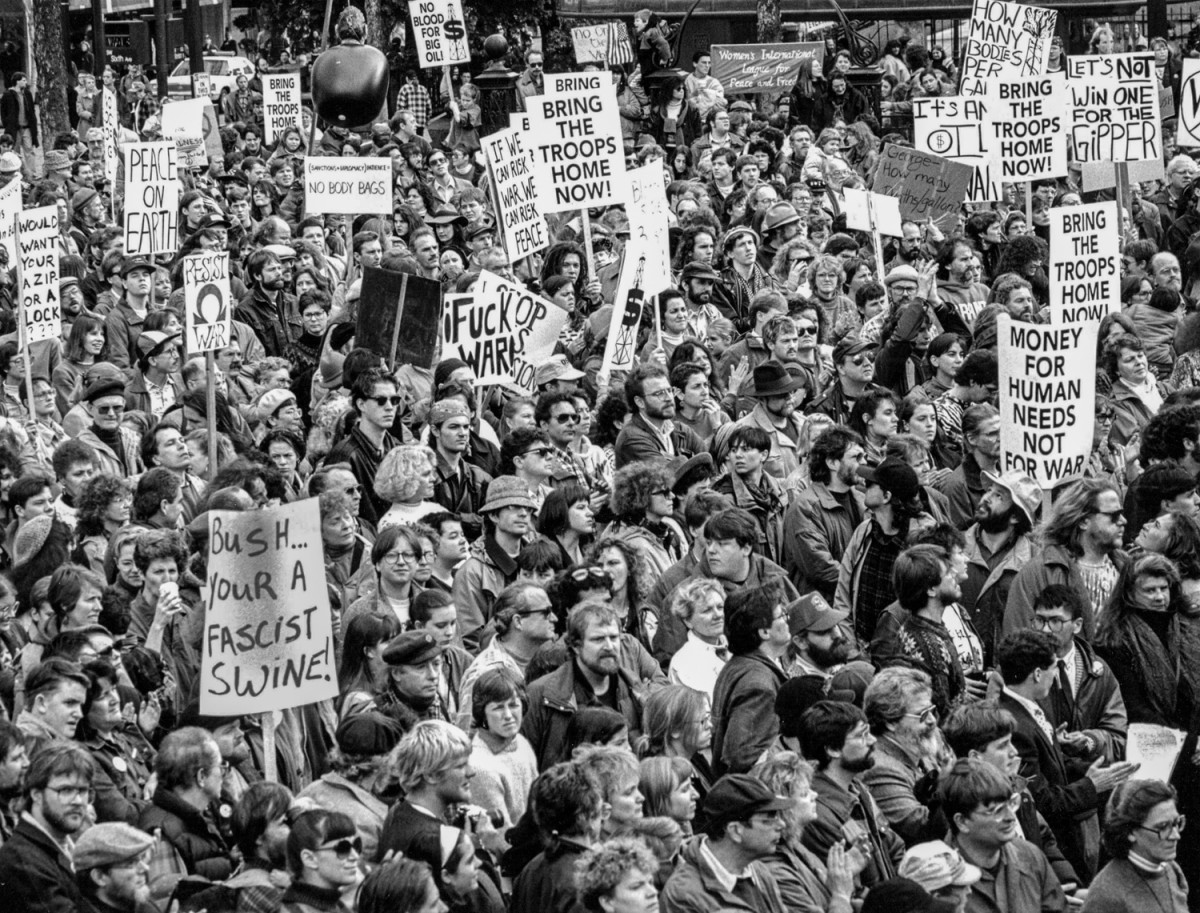
13. 1991 Protest against the First Gulf War in Iraq
The Gulf War in 1991 galvanized thousands of people to protest in the streets in Portland. In January 1991, over 12,000-15,000 marched to express their outrage at President George H.W. Bush for attacking Iraq. They shouted, “No Blood for Oil,” "No More Wars,” and “Bring our troops home,” and carried peace signs and huge banners. Many mothers carried signs with images of their sons in uniform who were serving in the US army and bound for Iraq. There were also several much smaller demonstrations by people who supported the war. Due to the hatred many activists had for Bush, his visits to Portland provoked intense confrontations with the police which ended in police attacks and many arrests. The intensity and hostility of the protestors towards Bush and his administration won Portland its nickname, “Little Beirut.”
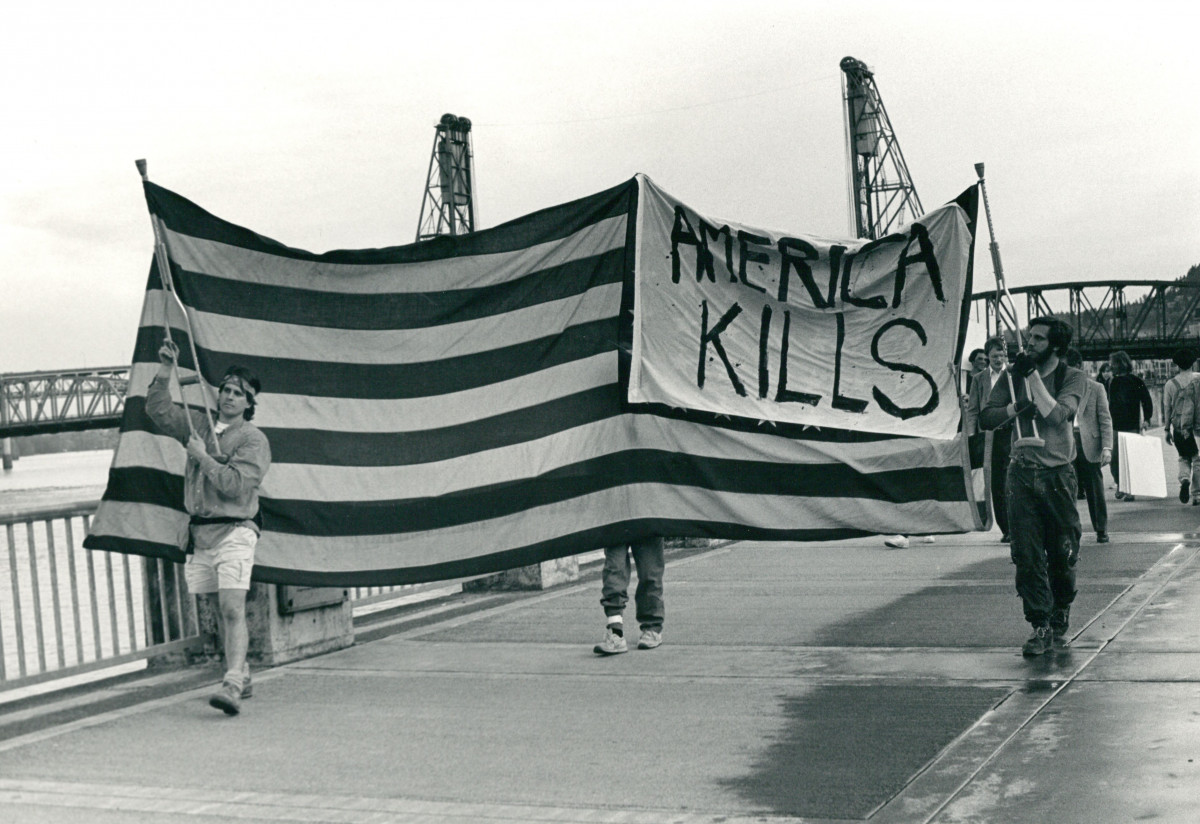
14. 1991 America Kills
America Kills. This terrifying truth, once realized, becomes inescapable. It struck a blow to what I had once believed about America, followed by a profound sadness suffused with outrage that never goes away. The official narrative about America as a shining light in the world, championing democracy and human rights, crumbled as I learned about its real history. The US was founded on violence, genocide and wars to steal land from the Native peoples, and on the brutal enslavement of millions of Africans, which devastated their lives for over 250 years. “Life, liberty and the pursuit of happiness” were accessible only to white men (mostly wealthy men of property); Native, Black, peoples of color, and women were excluded.
Throughout its history, the US Empire has always relied on violence and wars to achieve its goals. It has never changed its course in pursuit of global hegemony, attacking country after country through wars, sanctions, coups, occupations, black-ops, assassinations, torture, propaganda and terrorism. It became a “super predator,” armed with nationalism, white supremacy, American exceptionalism, and cruel indifference to human suffering. With “God on our side,” it dropped two nuclear bombs on Japan in 1945, which incinerated over 70,000 civilians, including thousands of Korean slave laborers in Hiroshima, and 35,000 in Nagasaki. The American war on Vietnam killed over 58,000 American soldiers (most of them between 21 and 28), and about 3.8 million Vietnamese. When the US military finally withdrew after 10 years of war, it left an estimated 80 milion unexploded cluster bombs in Laos, which have killed over 20,000 people. An estimated half a million of Vietnamese children were born with crippling deformities caused by Agent Orange, a chemical weapon used by the US military. According to Denis Halliday, a former UN assistant secretary-general, US economic sanctions killed more than 1 million Iraqis, who died from malnutrition and inadequate health care. The sanctions, in effect from 1990 to 2003, also killed over 500,000 children. Madeleine Albright, Clinton’s Secretary of State, summed up US policy when she declared on 60 minutes that “the price was worth it.” During 20 years in Afghanistan, the US dropped over 80,000 bombs and missiles on one of the poorest countries in the world. By the time the US withdrew in 2021, over 47,000 Afghan civilians and 2,448 US troops had been killed. Who benefitted from all these wars and so much suffering? The trails of blood lead to the ruling elites and US corporations like Lockheed Martin, Boeing, Halliburton, and General Dynamics. While they made a killing off the wars, entire countries were destroyed, millions of people were killed, or forced to flee to overcrowded and miserable refugee camps in hostile countries.
What can we make of the use of the nicknames “Fat Man” and “Little Boy” given to the atomic bombs dropped in Japan, the boasts of US generals, like Curtis LeMay that “We killed off...20% of the population,” and Dean Rusk’s statement, “We bombed everything that moved” in North Korea, the swagger of George Bush to “Bring it on!” and American pilots gleefully describing the lethal bombing of Iraqi troops retreating from Kuwait as a “turkey shoot”? It seems that for the US Empire, killing is fun.
All the July 4th fireworks every year, the chest thumping rah-rah “USA, USA! No. 1, No. 1!!” at political rallies, the national anthems played in football stadiums, and the thundering bombs dropped by B-52s and F-16s over countries like Vietnam, North Korea, Syria, Iraq and Afghanistan cannot silence the truth of these two words: America kills.
With over 800 military bases around the world, an ever-increasing military budget of over $753 billion this year, and the most powerful military in the world, armed with nuclear and high tech weapons, Martin Luther King’s urgent warning that “the US is the greatest purveyor of violence in the world” has become even more ominous as the US Empire lurches from the “War on Terror” to escalation with China.
Truth is often terrifying, but it also has the power to compel us to act for real change. We are the only ones who can resist the US empire, end its “endless wars,” and change its destructive course for world dominance, which has endangered the whole world and can only lead to the destruction of us all. We the people have the power; let’s use it!
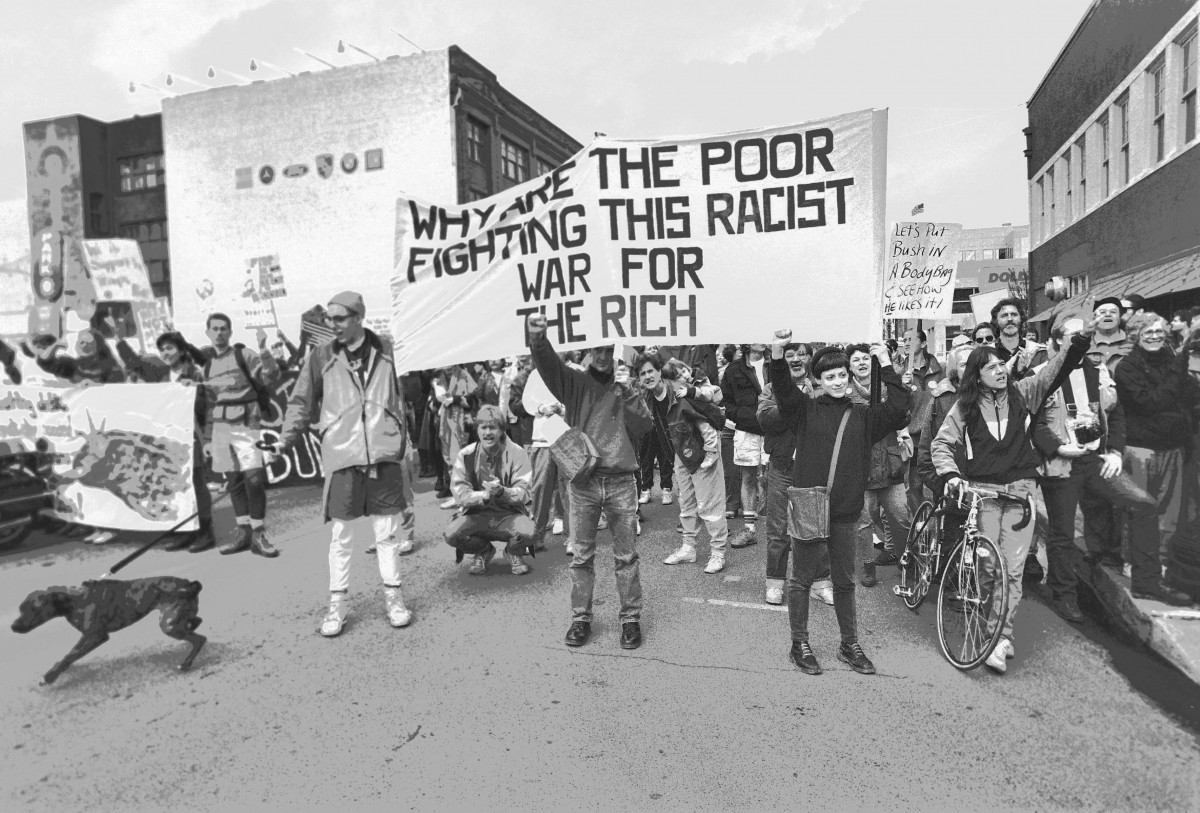
15. 1991 The Poor Fight the Racist Wars of the Rich
During a January 1991 visit to Portland, President George H.W. Bush was met by demonstrators protesting the Gulf War. According to police, between twelve and fifteen thousand people joined the protest, making it the largest Gulf War protest in the United States. The crowd gathered at
Pioneer Square for a rally and speeches before marching. Signs and slogans proclaimed “No Blood for Oil” and “Peace Now!” and “No More War! I really like the profound message of this sign. Because when you think about it, most of the men who enlist are poor. It is almost like an economic conscription. It is one of the few choices that they have left other than trying to get a job at McDonald’s. I also like how the dog of war is on a leash.
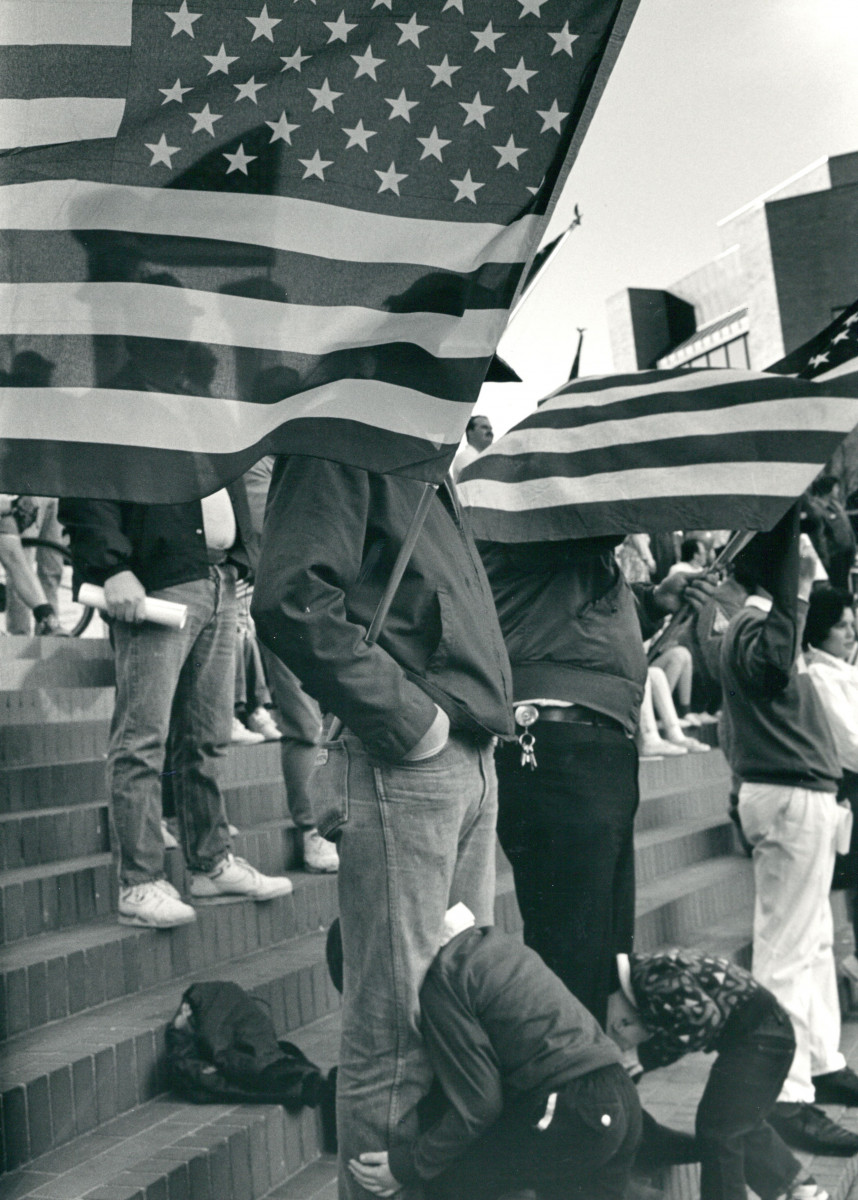
16. 1991 Flags and Fathers
Ironically, an image I photographed at a pro-Gulf War rally in 1991 turned out to be an anti-war image. It shows two huge American flags covering the faces of the two white men carrying them. Their two young sons, who were probably bored and just goofing off, have stuck their heads between their fathers’ knees. The huge flags which dominate the image, and the juxtaposition of the headless fathers with their headless sons, symbolize the power of nationalism in America. Its ideology has tremendous power to obliterate critical or independent thinking. It demands submission without question or doubt. It’s a religion that is passed down from fathers to sons, compelling them to march off to fight and/or die in endless wars that they know very little of, except what they’re told to believe.
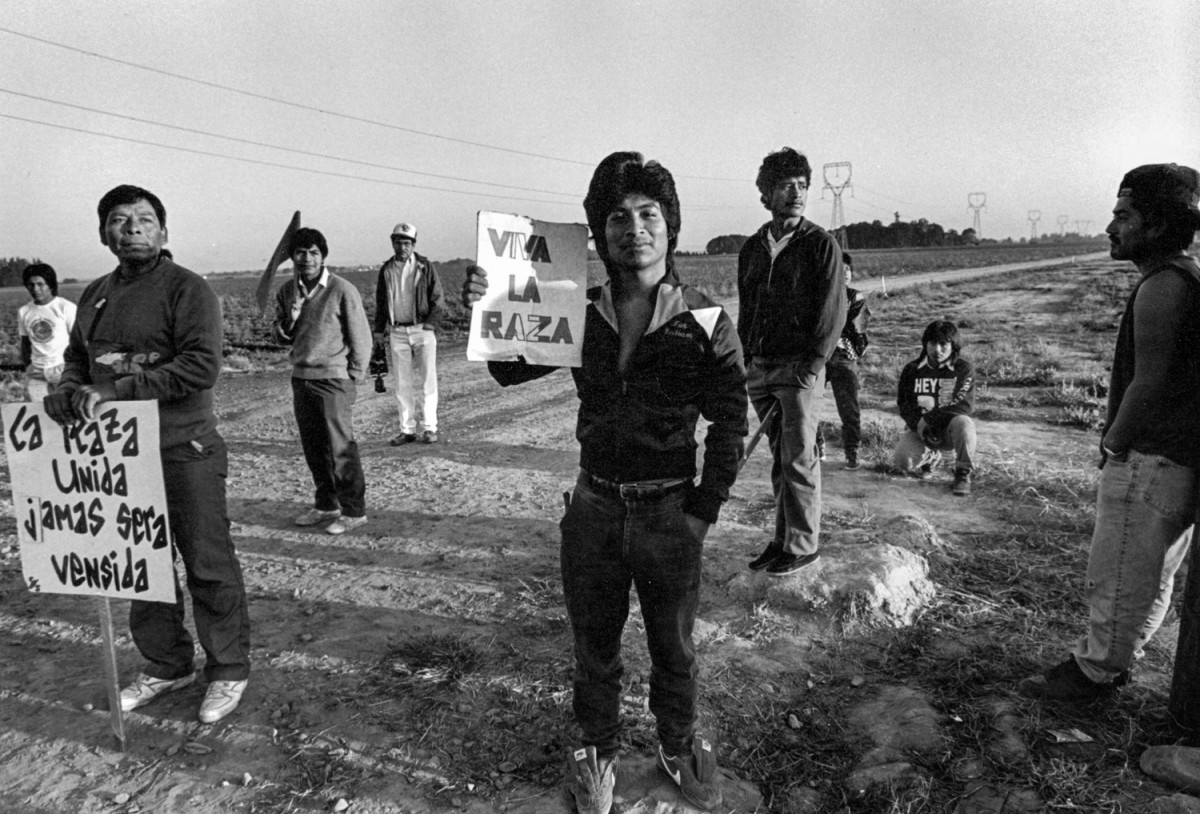
17. 1991 Farmworkers Strike
Farmworkers went on strike in 1991 to protest the working conditions and poor wages at the Kraemer Farm in Woodburn, OR. The workers were organized by Pineros y Campesinos Unidos del Noroeste, PCUN. It was the first union organized farmworkers strike in Oregon. The strike succeeded in getting a 33% wage increase for the workers.
I was present on the first day of the strike from 5 AM till nightfall. I was able to spend time with the farmworkers, learning about their working and living conditions. Many workers were paid by piece rate which often came short of the minimum wage of $4.75 an hour. Many of them were shortchanged by their employers; they also had to pay overinflated prices for sub-standard housing (they slept in a huge windowless building on hard bunk beds), poor quality food, and for the buses which drove them back and forth from the farms. At the end of the day, not much was leftover from their wages for a hard day’s work. I could tell from their faces that they had been through hard times. The strike was well organized by PCUN, with a lot of local and national media coverage. This was a victory for the workers that was truly deserved! However, the struggle for the farmworkers’ rights continued for many years as they had to fight against anti-immigrant legislation, anti-union tactics, and the use of pesticides by the bosses and NORPAC growers. As the union PCUN grew, their motto “Si se puede” (yes, we can!) motivated workers to continue their struggle to improve their working conditions and their lives.
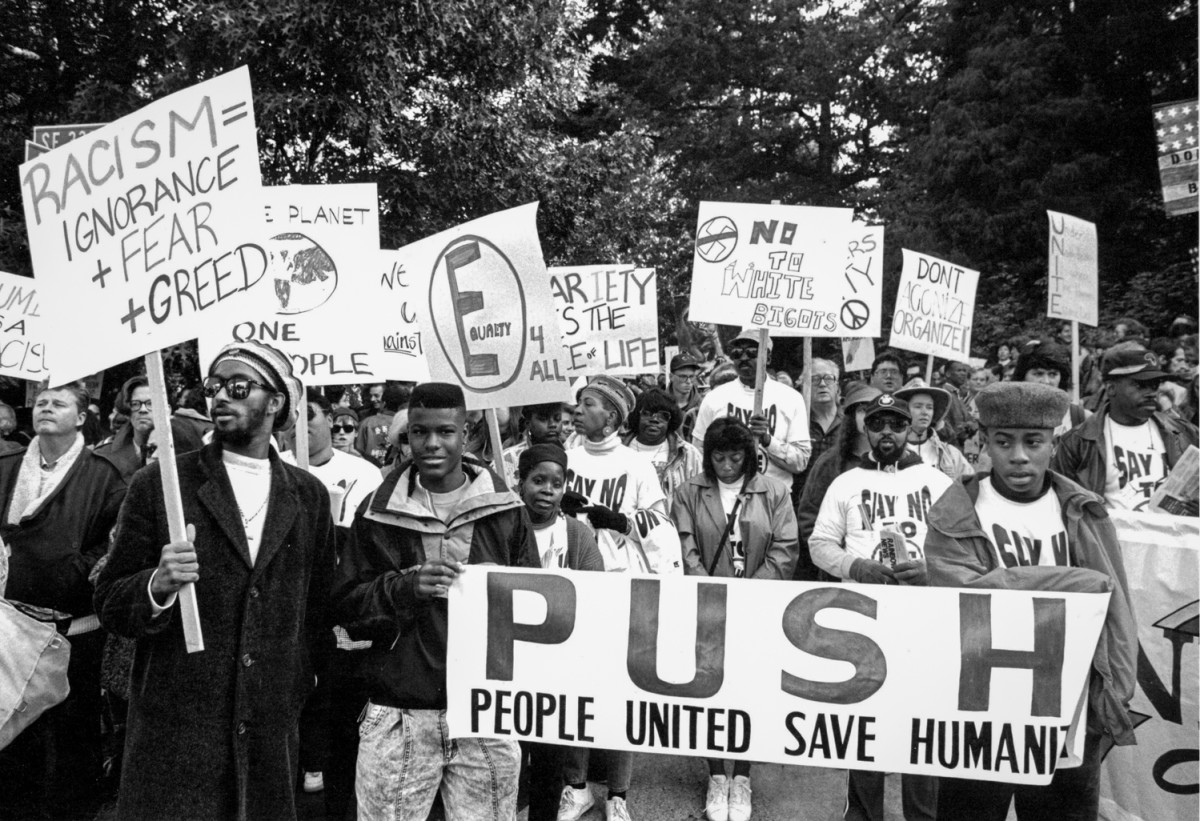
18. 1990 Protest against the killing of Mulugetu Seraw
On November 13, 1988, Mulugetu Seraw, a 28-year old Ethiopian immigrant, was beaten to death by three white supremacist, neo-Nazi skinheads. The three killers, Ken “Death” Mieske, Kyle Brewster (who was the homecoming king of Grant High School), and Steve Strasser, were members of East Side White Pride and White Aryan Resistance (WAR). All three were arrested and convicted. Mieske was given a life sentence; he died in 2011, without expressing any remorse for killing Seraw “because of his race.” According to Willamette Week article on Jan. 17, 2021, Kyle Brewster, who had been released from prison in 2002, was seen at a pro-Trump rally with the Proud Boys in Salem on Jan. 6, 2021.
Many Portlanders were stunned by Seraw’s murder, which shattered the illusion of Portland being a progressive, liberal city. They were shocked to discover that Portland was considered the “skinhead capitol,” and a fertile ground for neo-Nazi skinheads, who had been organizing, recruiting and spreading their racist propaganda for years. During the 1980s and 1990s the racist skinheads, with their trademark black boots and leather jackets, were part of the popular punk scene in this whitest of American cities. Their increasingly violent attacks targeted people of color as well as gays and lesbians and “hippies,” and led to clashes with anti-fascist skinheads, who called themselves Skinheads Against Racial Prejudice (SHARP). Members of SHARP, Anti-Racist Action (ARA) and Coalition for Human Dignity (CHD) confronted the neo-Nazis outside clubs and in the streets, and tried to drive them out of Portland.
In 1990, the “Dignity and Diversity” march and rally were organized by CHD, ARA, SHARP and over 30 community groups. Over 5,000 people marched from where Seraw was murdered to Portland State University, where John Trudell, Hitting Birth and other musicians performed. This image was made at the beginning of the march.
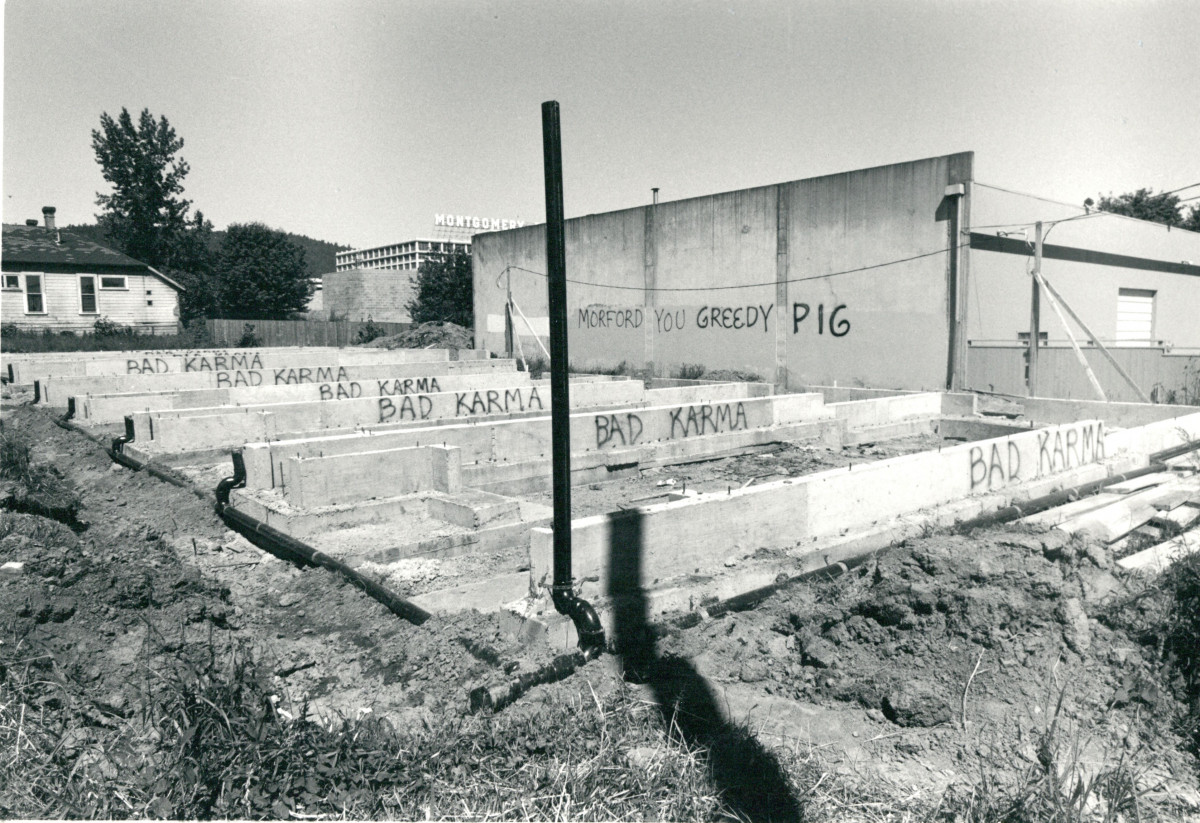
19. 1989 Bad Karma
Portland has been one of the most gentrified cities in America from the late 1980s to the present. By 2017, it had become the fourth fastest gentrifying city in the US, according to Realtor.com. Real estate prices skyrocketed, and rising rents forced many workers and the poor to move to outer SE and NE areas of the city or farther into Gresham and elsewhere. African-American residents were one of the hardest hit, as an estimated 10,000 out of 38,000 had to move out of historically black neighborhoods, especially Albina and NE Portland.
NW Portland was transformed from a diverse neighborhood of artists, writers, retirees, and workers into a yuppie haven. In 1989, Lake Oswego developer Phil Morford bulldozed several old vintage houses in NW Portland to build upscale townhouses. His actions outraged many residents, and on Sept. 7, a fire burned down one of his construction sites located on NW Thurman, causing $250,000 in damages. Although the police suspected arson, and Earth First activists as the culprits, no one was arrested.
This image, Bad Karma, documented an act of resistance by unknown protestors against Morford’s relentless destruction of the beautiful old houses and the NW neighborhood. While his real estate investments made him millions, NW Portland was forever changed from an affordable, interesting neighborhood to a place dominated by luxury townhouses and fancy boutiques catering to the well-heeled.


